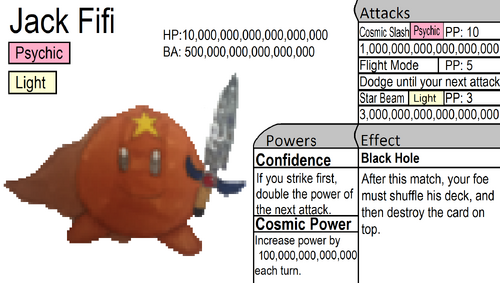
a catch card of a fire fifi
There is also another type of catch card game, with the same basics, simply a different style.
Requirements
- 3 x 5" notecards
- a pencil/pen
- crayons/markers/colored pencils, for those who enjoy a good colorful card.
How to make a catch card

A digitally made catch card. This card represents Jack, the second in command of all fifis.
Start by drawing your character on the left side of the card.

A rolling spike fifi.
Name it and put that name in the top-left corner.
Underneath the name, put the type of your creature (ie: fire, water, plant, electric, ice, ect.)
Give your creature an amount of maximum HP, a base attack, and it's defense. Your base attack will serve as a backup move if you run out of uses on everthing else, and has no type at all. Your defence is a number that is taken away from all damage your card takes. Most cards have no defence at all.
Next, draw a vertical line just to the right of your creature, and label it "attacks."
Put two or three moves, the amount of times you can use them, and what they do. Be sure to give all of your attacks a type, too.
Next, draw a line and write "effect."
Name your effect and list what it does.
Next. make a portion sticking out of the vertical line, and label it "power."
Many people confuse the power and the effect of a creature. The effect is what happens to another card, while the power affects your creature. For example: ability: absorb fire type attacks and restore HP. Effect: Unless your foe is a water type, they take 50 damage from fire each turn.
Color your card.
If you want, you can give your card a special move, and put it on the back of your card. Your special move can only be used once, but is extremely strong. It is usually the same type as the user.
Battling
A catch card battle is a turn-based battle, with each player taking turns using a move with his creation.
Place your deck of cards face down and draw the top five cards. These will go in your hand. Everyone places the card of their choice down at the same time, and they battle.
If your cards wins a battle, you may place it in the battlefield. (Note: this is optional!) Then you can use it again whenever you want, but must discard it afterwards. Your foe can attack a card in the battlefield, but does not have to.
Immediately after a battle ends, a five-second countdown is started. When time runs out, players must have their card selected and put it down.
When a card loses, place it in the graveyard (wherever you feel like putting it.)
One player wins when the all the foe's cards have been defeated. These battles can sometimes take a very long time, for those who have very large decks.
Special cards
There are three types of special cards. There are summon cards, item cards, and effect cards.
Summon Cards
Summon cards usually come in pairs of at least three. If all three summon cards are placed on the field, they combine to summon an even stronger card. (The fire fifi is part of a three-card summon set, if combined with the water fifi and plant fifi, it summons the elemental fifi.)
Item Cards
An item card can be used to enhance the powers of another card. They can be many things, such as weapons, armor, vehicles, traps, potions, or amulets. Really, whatever you want, as long as it's an object.
Effect Cards
Effect cards are cards made just for their effect, and usually have very powerful effects, but they cannot attack. They are given a certain amount of hp and a powerful effect. Your opponent gets one attack, and if it doesn't finish off your card, your effect takes place.
Power Scale
Some cards are on a different "power scale." A damage scale is if somebody's deck of cards average power ranges from 100-500 while the other deck is 1,000-5,000. To make this battle fair, the person with 100-500 power would get to add a 0 to the end of everything it does. Power ranges aren't always this easy to calculate, but make it fair.